Hens and Chicks are hardy perennial plants grown indoors and outdoors. Having them in the garden or inside the home will bring a unique look. By looking at them, a common question that comes to everyone’s mind is whether hens and chicks are succulents or not.
So, let’s find out.
Hens and Chicks, also known as houseleek, is a popular and low-maintenance succulent plant. Thick leaves that store water and nutrients and the ability to stand harsh weather conditions like harsh sun, dry conditions, and low humidity matches with that of a succulent, making a clear distinction.
Knowing the type of the plant makes it easier to care about them. Even surviving in negligence, a little care can help them thrive more. This article will explain whether Hens and Chicks are succulents or not and how to care about them to get more of them.
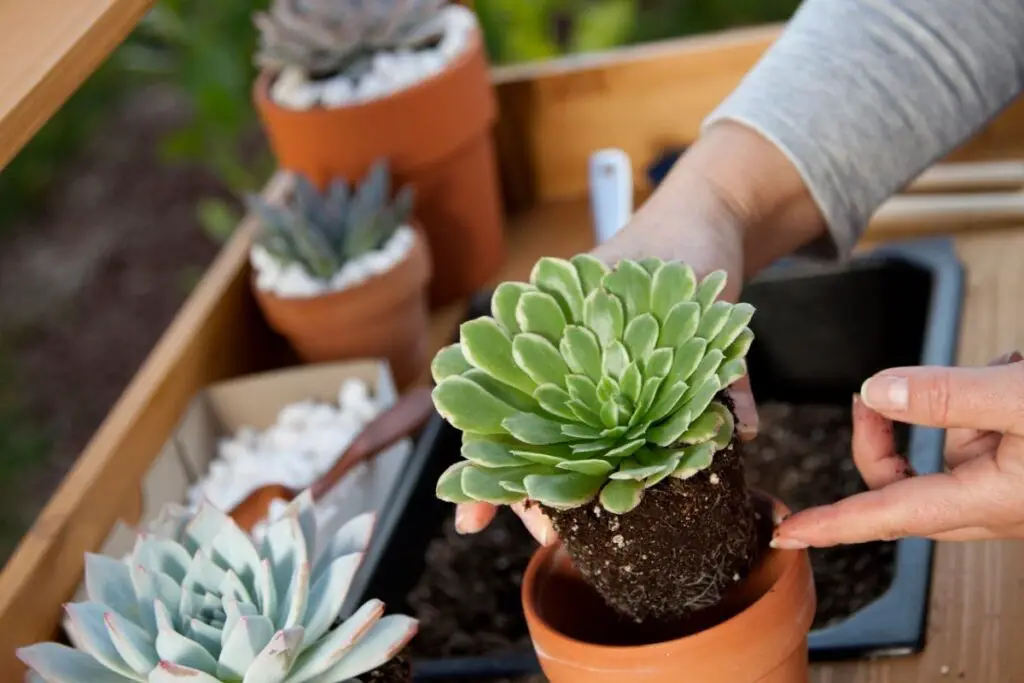
Are Hens and Chicks succulent or cacti?
Typically, Hens and Chicks are called succulent plants. The reason is their features which match with normal succulents.
The succulents are drought-resistant plants, and they are famous for their ability to survive with neglect. One of the most defining features of succulents is storing water.
The plant can store water in its stems, leaves, and roots. They save this water for use when the weather gets too dry. That is why they don’t need frequent watering and can resist extended dry conditions.
Hens and Chicks hold the same quality of holding moisture. Thus, they can survive drought conditions.
Some people confuse Hens and Chicks being cacti because they have little thorns. Cacti are succulents, but Hens and Chicks are not cacti. Cacti also store water in their leaves and stems.
One feature in the cacti not present in Hens and Chicks is Areoles. These are tiny bumps found on the surface of a cactus plant through which spines or thorns appear.
This is one thing that will help you distinguish between a succulent and an actual cactus plant.
The Hens and Chicks have sharp and pointed leaf tips, resembling thorns. The leaf edges are like minute little teeth.
These pointed tips are regular and don’t grow from any areoles. This is enough to conclude that Hens and Chicks are not cacti but succulents.
You can say that all cacti are succulents because they store moisture in them, but all succulents are not cacti because all succulents don’t have areoles.
After this distinction, it is clear that Hens and Chicks are succulent and not cactus.
Do Hens and Chicks require succulent soil?
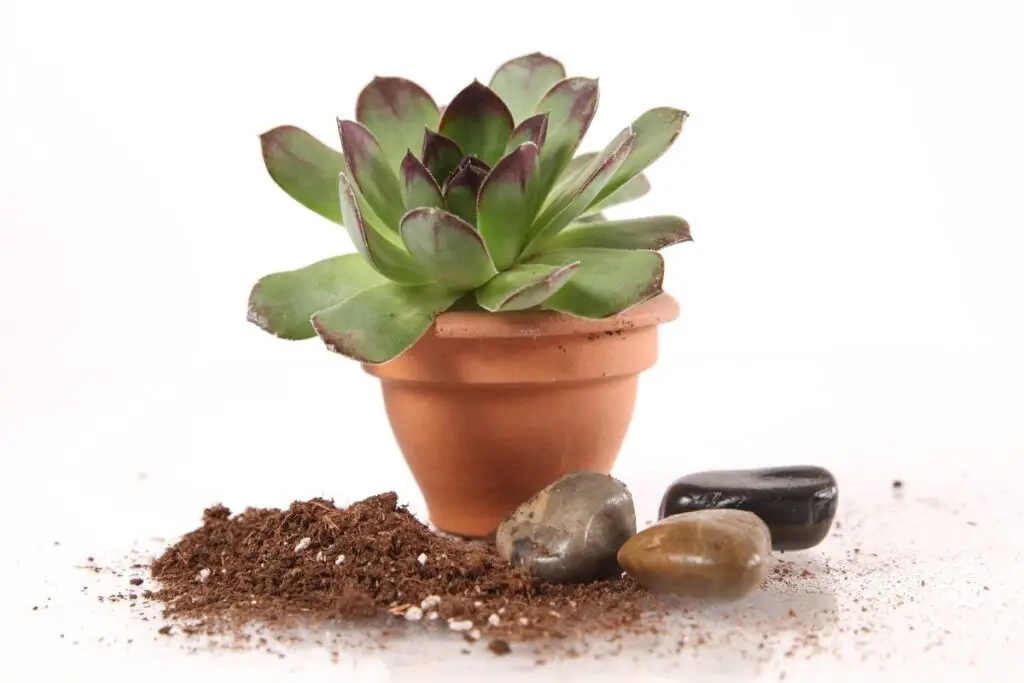
Hens and Chicks don’t need vibrant soil for thriving. Typically, you can use garden soil and sandy soil and enjoy them easily without any hassle.
The garden or sandy soil has a neutral pH level, ideal for Hens and Chicks. You can also grow them in stones, rocky soil, and gravel.
You can use cactus or succulent soil for growing Hens and Chicks if you don’t want to use garden or sandy soil. This succulent soil mix contains perlite and pumice, which support adequate drainage.
Moreover, this soil has a pH level perfect for Hens and Chicks. This soil mix is best if you want to grow Hens and Chicks in pots.
The commercial succulent soil contains ingredients that can prevent the water from being stuffy, avoid root rot, pest, and fungus infestation. This soil mix will not require any mixing with other types of soil.
Perlite is a bit costly. If you cannot afford it, you can use a 50-50% mixture of garden soil and sandy soil.
How to care for Hens and Chicks?
These beautiful succulents are unique because of their bright rosettes available in many colors like primarily red, green, and copper. They are effortless to care, and they can even multiply by producing many chicks.
You can divide and grow them if you want more Sempervivums.
Though they don’t need much attention, there are certain things you should know to stop them from any suffering. Below, I have shared some of their essential needs and care tips for these succulents.
Looking for gardening supplies? We have tested 100's of products before recommending them to you guys. Check out our best pick below:
| Image | Gardening Supplies | Best Price? |
|---|---|---|
 Top
Top Top
Top | Raised Garden Bed Kit | Check On Amazon |
 | XLUX Soil Moisture Meter, Plant Water Monitor, Soil Hygrometer Sensor for Gardening, Farming, Indoor and Outdoor Plants, No Batteries Required | No Results |
 Top
Top Top
Top | 82 Pcs Garden Tools Set and Extra Succulent Tools Set | Check On Amazon |
 | Joeys Garden Expandable Garden Hose with 8 Function Hose Nozzle, Lightweight Anti-Kink Flexible Garden Hoses, Extra Strength Fabric with Double Latex Core, (50 FT, Black) | No Results |
 Top
Top Top
Top | Dual Chamber Compost Tumbler | Check On Amazon |
 Top
Top Top
Top | Sunnyglade Plant Stakes | Check On Amazon |
 Top
Top Top
Top | Organic Cold Pressed Neem Seed Oil | Check On Amazon |
 Top
Top Top
Top | Mighty Mint Gallon :-Insect and Pest Control Peppermint Oil | Check On Amazon |
 Top
Top Top
Top | Scotts DiseaseEx Lawn Fungicide | Check On Amazon |
 Top
Top Top
Top | Jacks Classic 20-20-20 All Purpose Fertilizer | Check On Amazon |
 Top
Top Top
Top | 30,000 Seeds Pollinator Attracting Wildflower Mixture | Check On Amazon |
 Top
Top Top
Top | Survival Vegetable Seeds Garden Kit-Over 16,000 Seeds | Check On Amazon |
The best soil for these succulents
These pretty succulents can grow in poorly nutritious soil, rocky soil, gravels, and even over stones. You don’t have to give them rich soil. The one thing you need to care about is drainage.
The soil medium you use should have a sound drainage system. You can use succulent soil as perlite and pumice, which will support excellent drainage.
If you don’t want to use commercial soil, you can also use a mixture of garden soil and sandy soil with a 1:1 ratio. These will help to retain moisture and drain water, respectively.
These plants will grow over gravels and stones, which is their natural environment. The only thing is in these two mediums, and you have to water them regularly during the dry summers.
Avoid using pure clay or pure sandy soil. One can hold moisture forever, and the other will not hold moisture for long.
Also read: What Kind Of Soil Do You Use For Hens And Chicks? (+Best Soil Mix)
How to water Hens and Chicks?
These plants can tolerate droughts but won’t enjoy standing in water. Being drought-tolerant doesn’t need they will not require any water.
In general, the Hens and Chicks need watering once a week. Just ensure not to overwater these plants. Watering depends on many factors like the type of plant, soil, and time of year. So, you need to water according to it.
The best way is to water them only when the top 1 to 2 inches of soil dries out nicely. Water the soil and plant base and avoid the leaves. Controlling the moisture level will help to avoid both overwatering and underwatering.
When you grow them in gravels or stones, watering once or twice will not be enough, especially in dry weather. You might need to water regularly.
Also read: How Much Water Do Hens And Chicks Need? (Underwatering+Overwatering)
Light required for Hens and Chicks
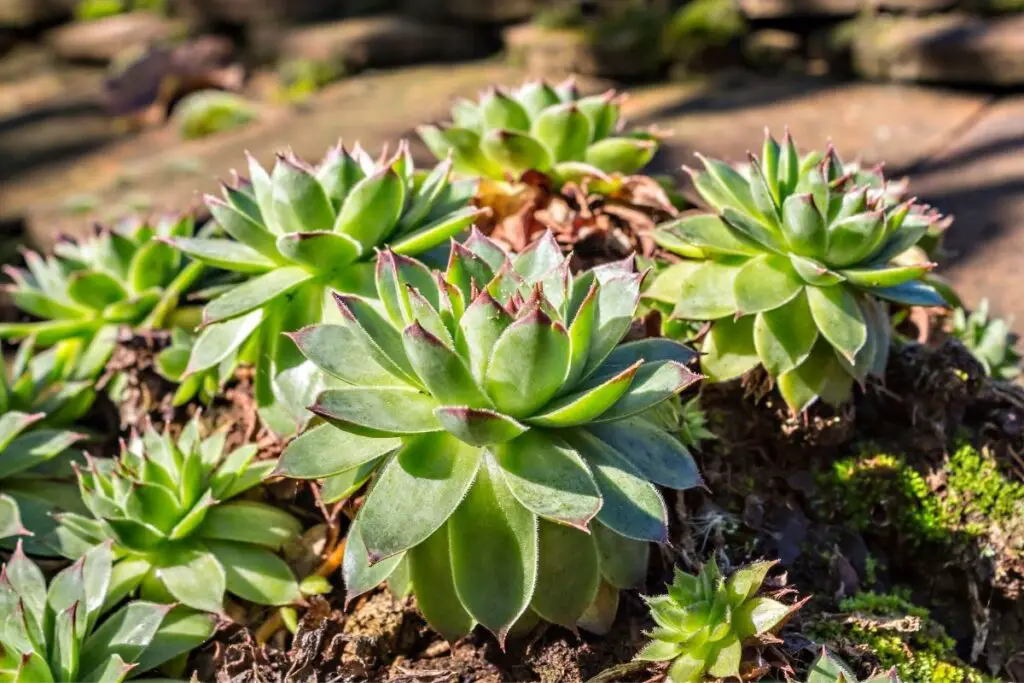
Most Hens and Chicks will grow in full sun for at least 8 to 10 hours. A lot of sunlight brightens up their color and makes the leaves juicy. They will even survive in partial sun, depending on the variety.
But they will not survive in full shade. These succulents will need at least partial light for 4 to 6 hours. If there is a lack of sunlight, you can fix artificial lights for the plants outdoors.
These plants might get sunburnt if they get a high intensity of sunlight. At such conditions, you have to amend by sheltering them and watering them more often.
Also read: How Much Sun Do Hen And Chicks Need? (Light Requirement)
Temperature and humidity
These succulents prefer a temperature ranging between 65 to 70°F. When the temperature is too low, 30°F or below in your region, they will still survive.
Being cold-hardy plants, Hens and Chicks will not die but stop growing and enter into a dormant period.
They can tolerate an average level of humidity. A humidity level of around 30 to 50% will work. These plants don’t require any extra humidity.
Fertilizer
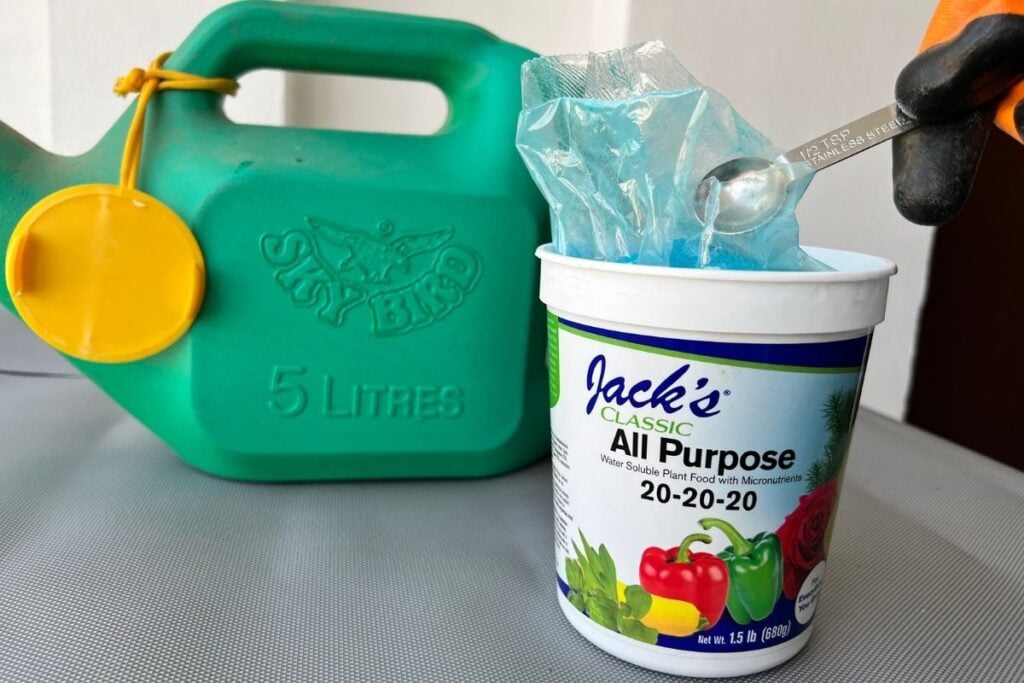
These plants don’t require extra nutrients to be healthy, as I said earlier. They tend to release auxins which can stimulate their growth. They can thrive easily in infertile soil.
Still, if you want to fertilize them, you can do it once a year or once a month in the growing season, i.e., during the spring and summer.
Fertilizing in the spring will encourage rapid growth and more daughter plants. Fertilizing in summer will support healthy flowering.
Use mild fertilizer and always dilute it to ½ the strength even if it’s mild.
Also read: Do Hens And Chicks Need Fertilizer? (+Best Fertilizer For Hens And Chicks)
Leave them alone
Let these succulents be alone. Bothering them too much by watering or fertilizing can make them uncomfortable and weak. They don’t need frequent watering or fertilizing. So, let them be.
Don’t overcrowd them
This is not something done manually wrong. It is nature’s way.
Overcrowding can let the big rosettes die and overgrow by taking over other plants. Check whether they are spreading every 2 years and divide them as needed.
Remove the blooms
The blooms will die after they finish flowering. Removing them stops them from making seeds and increases their lifespan.
Will Hens and chicks succulents grow inside?
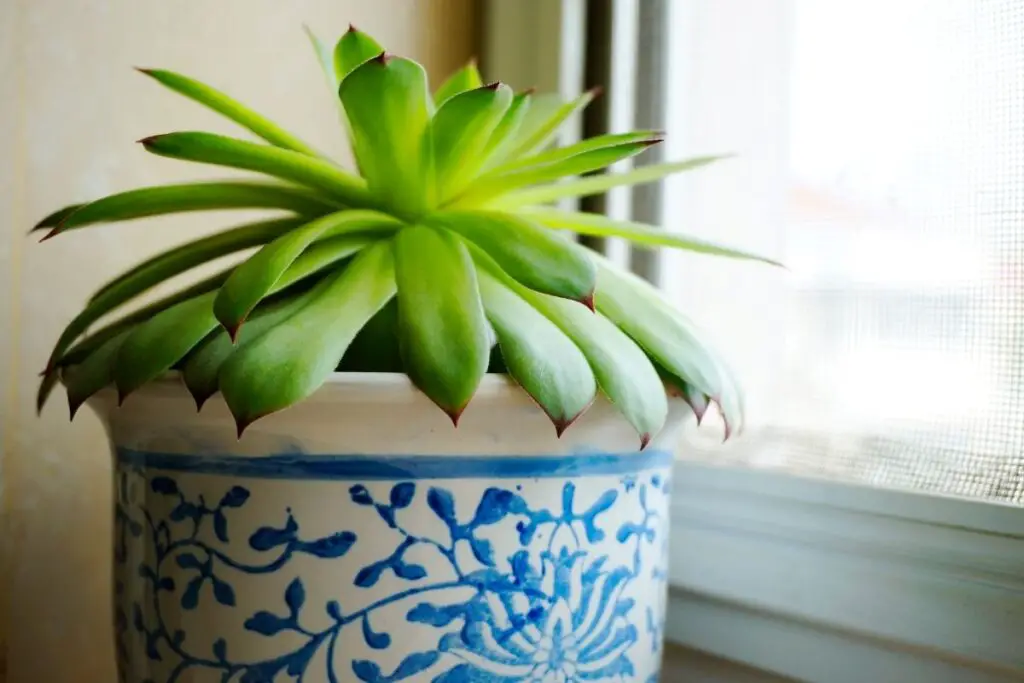
Hens and Chicks can be grown both indoors and outdoors. They can grow in containers very well. If you stay in the colder areas, you can relish them indoors the whole winter.
Another advantage is they can be shifted from one place to another, depending on the sun and temperature, when grown in pots.
For having a successful growth indoors:
Choose a porous pot, having drainage holes and sizes slightly bigger than the plant. Choose a long, wide, and shallow pot. Their roots are shallow, so you don’t need any deep pots.
You can use succulent soil mix. They are excellent drainage and won’t let your plant stand in water. You can also use a mixture of garden and sandy soil. Hens and Chicks would be thriving.
Water only when necessary. Generally, you can water once a week. Don’t water in winters. Let them have full sun or partial sun for at least 6 to 8 hours. Place them near an open window.
They like temperatures ranging between 65 to 75 degrees Fahrenheit. The indoor surrounding can give them this temperature.
Fertilizing is not mandatory. Do it only when you find them not growing. Little mild fertilizers might encourage their growth. Do it during the spring or summer.
Don’t disturb them by watering or fertilizing in winters. They remain dormant in winters. Disturbing can make them weak.
Protect your plant from pests and diseases. Avoid putting plants too close. Don’t let the leaves moist for long. Let them have proper ventilation, especially in summers.
Final words
Hens and Chicks are pretty succulents belonging to the members of Sempervivum groups. They are considered succulents due to storing water in the leaves, stems, and roots.
Their leaf tips are sharp, resembling thorns. But because they don’t have areoles, they are not considered cacti. Some people may confuse them as cacti, but they are not. They are succulents and will grow nicely when planted in poor or succulent-based soil.
Let them have full or partial sun, don’t water them until the soil dries, and you can skip fertilizing if you are a beginner.
Without fertilizing, too, they can thrive. You can also grow them in gravels, rocky soil, or stones instead of succulent soil. With this much care and attention, you can see these lovelies thriving and producing new baby plants.
Reference: Wikipedia, Iowa State University of Science and Technology, The University of Arkansas Division of Agriculture, NSDU, The Ohio State University, Missouri Botanical Garden.
